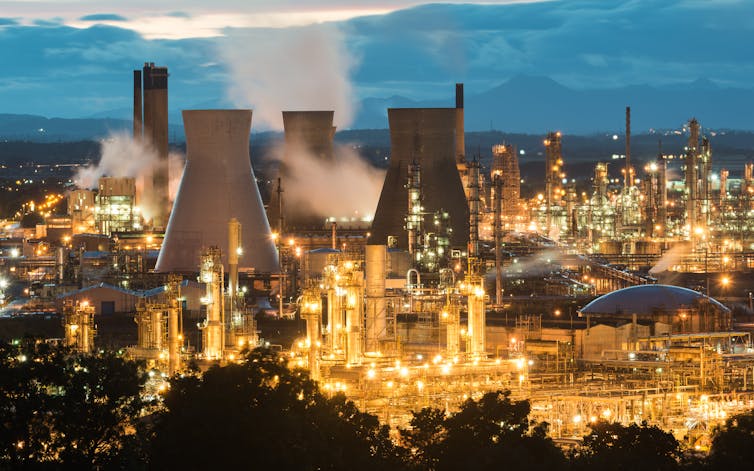
A new direct action group calling itself the Tyre Extinguishers recently sabotaged hundreds of sports utility vehicles (SUVs) in various wealthy parts of London and other British cities. Under cover of darkness, activists unscrewed the valve caps on tyres, placed a bean or other pulse on the valve and then returned the cap. The tyres gently deflated.
Why activists are targeting SUVs now can tell us as much about the failures of climate policy in the UK and elsewhere as it can about the shape of environmental protest in the wake of Extinction Rebellion and Insulate Britain.
The “mung bean trick” for deflating tyres is tried and tested. In July 2008, the Oxford Mail reported that up to 32 SUVs were sabotaged in a similar way during nocturnal actions in three areas of the city, with anonymous notes left on the cars’ windscreens.
In Paris in 2005, activists used bicycle pumps to deflate tyres, again at night, again in affluent neighbourhoods, again leaving anonymous notes. In both cases, activists were careful to avoid causing physical damage. Now it’s the Tyre Extinguishers who are deflating SUV tyres.
In the early 2000s, SUVs were still a relative rarity. But by the end of 2010s, almost half of all cars sold each year in the US and one-third of the cars sold in Europe were SUVs.
In 2019, the International Energy Agency reported that rising SUV sales were the second-largest contributor to the increase in global CO₂ emissions between 2010 and 2018 after the power sector. If SUV drivers were a nation, they would rank seventh in the world for carbon emissions.
At the same time, the Tyre Extinguishers’ DIY model of activism has never been easier to propagate. “Want to get involved? It’s simple – grab some leaflets, grab some lentils and off you go! Instructions on our website,” chirps the group’s Twitter feed.
Changing activist strategy
Though the actions led by the Tyre Extinguishers have numerous precedents, the group’s recent appearance in the UK’s climate movement does mark a change of strategy.
Extinction Rebellion (XR), beginning in 2018, hoped to create an expanding wave of mobilisations to force governments to introduce new processes for democratically deciding the course of climate action. XR attempted to circumvent existing protest networks, with its message (at least initially) aimed at those who did not consider themselves activists.
In contrast, activists in the Tyre Extinguishers have more in common with groups that have appeared after XR, such as Insulate Britain, whose members blockaded motorways in autumn 2021 to demand government action on the country’s energy inefficient housing. These are what we might call pop-up groups, designed to draw short-term media attention to specific issues, rather than develop broad-based, long-lasting campaigns.
After a winter of planning, climate activists are likely to continue grabbing headlines throughout spring 2022. XR, along with its sister group, Just Stop Oil, threaten disruption to UK oil refineries, fuel depots and petrol stations. Their demands are for the government to stop all new investments in fossil fuel extraction.

The Tyre Extinguishers explicitly targeted a specific class of what they consider anti-social individuals. Nevertheless, that the group’s action is covert and (so far at least) sporadic is itself telling.
In his book How to Blow up a Pipeline, Lund University professor of human ecology Andreas Malm asked at what point climate activists will stop fetishising absolute non-violence and start campaigns of sabotage. Perhaps more important is the question that Malm doesn’t ask: at what point will the climate movement be strong enough to be able to carry out such a campaign, should it choose to do so?
Given the mode of action of the Tyre Extinguishers, the answer on both counts is: almost certainly not yet.
The moral economy of SUVs
For now, the Tyre Extinguishers will doubtless be sustained by red meat headlines in the right-wing press. It’s still probable, however, that the group will deflate almost as quickly as it popped up: this is, after all, what has happened with similar groups in the past.
The fact that activists are once again employing these methods speaks to the failure of climate policy. Relatively simple, technical measures taken in the early 2000s would have solved the problem of polluting SUVs before it became an issue. The introduction of more stringent vehicle emissions regulations, congestion charging, or size and weight limits, would have stopped the SUV market in its tracks.
SUVs are important because they are so much more than metal boxes. Matthew Paterson, professor of international politics at the University of Manchester, argues that the connection between freedom and driving a car has long been an ideological component of capitalism.
And Matthew Huber, professor of geography at Syracuse University in the US, reminds readers in his book Lifeblood that oil is not just an energy source. It generates ways of being which become culturally and politically embedded, encouraging individualism and materialism.
Making SUVs a focal point of climate activism advances the argument that material inequality and unfettered individual freedoms are incompatible with any serious attempt to address climate change.
And here lies the crux of the conflict. The freedom of those who can afford to drive what, where and when they want infringes on the freedoms of the majority to safely use public space, enjoy clean air, and live on a sustainable planet.
---------------------------
This blog is by Graeme Hayes, Reader in Political Sociology, Aston University and Cabot Institute for the Environment member Dr Oscar Berglund, Lecturer in International Public and Social Policy, University of Bristol
This article is republished from The Conversation under a Creative Commons license. Read the original article.
